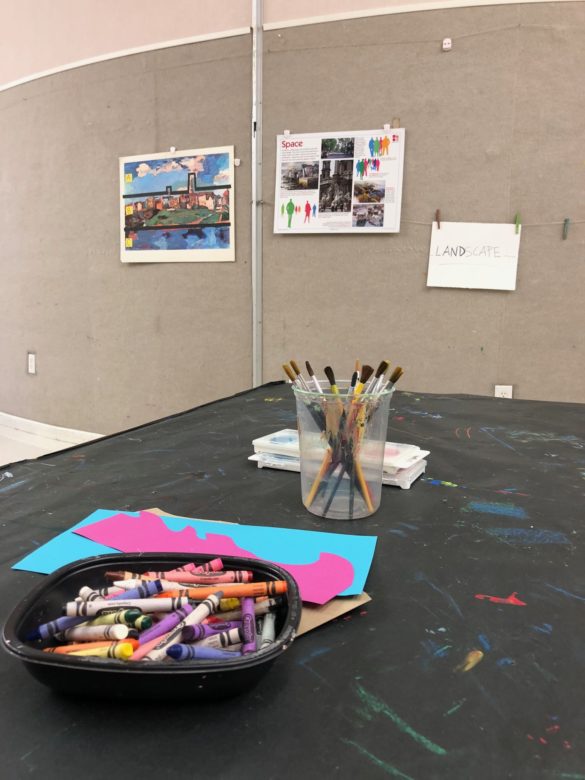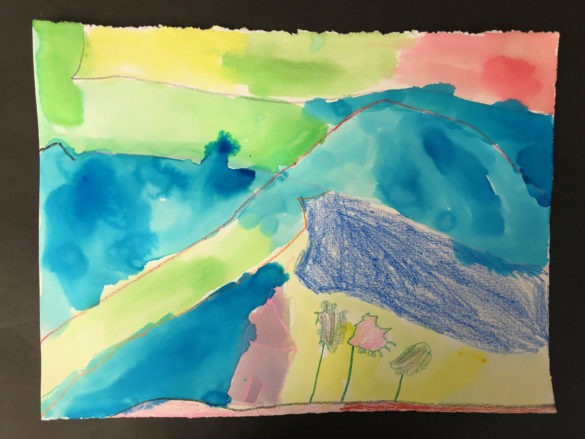By Meredith Tousey Matthews, Instructor

Art for Two participant Poppy rolls printing ink over her cardboard collage before printing a collagraph of her cityscape
A Day in the Class
A group of 3- to 5-year-olds are in the studio, crouched down in front of a line of stools that each have an identical object atop them. Peering with one eye open, they begin to giggle as they realize that the object closest to them looks much bigger than the ones farther away, even though they’re actually the same size. “This one is in the foreground!” says one of the kids, pointing to the first object.
We have just been visiting the landscape paintings in the traveling exhibition, Mediterranea. Sitting together below one of the pieces, we read a book about a wolf in search of the best view in the world. While standing at each painting, and looking at each illustration in the book, we noticed the three main parts of a landscape that serve to give it space — foreground, middle ground, and background.

The studio is set for an Art for Two lesson on the three zones seen in landscape paintings
Now, we are in the studio, preparing to create our own landscape paintings, but first we have some fun with the concepts we talked about in the gallery. After the “relative size” experiment with the stools, we put together a landscape puzzle in three pieces, and find some more examples of the three landscape zones. Then, just like the wolf in the story, we start to envision our own perfect view. Drawing with crayon, the children create three zones in their landscapes, and add watercolors, bringing their views to life. Playing in the background is some Spanish guitar music, harkening back to the Mediterranean, where we started.

An Art for Two participant’s best-view landscape painting
About the Class
The Art for Two class meets every second Saturday of the month from 10:30 a.m. to noon. 3- to 5-year-olds are accompanied by an adult, and each class has a theme prompted by the Museum collection, traveling exhibitions, or the gardens. Incorporated into each theme is a related element of art and a principle of design that informs a studio project for the children to take home. Making these connections between great works of art and landscape design and the personal creation of art creates a holistic museum experience. Seeing that a work of art is not the objective result of skill-building, with a good or bad result, but rather the subjective response to life, open to individual judgement, is empowering. The enchanting part of watching preschool-aged children talk about and create art is that, for the most part, they haven’t come to know any other mindset. They are in the process of building their own perspective, their response to life, and art impacts them easily and fluidly.
The multi-faceted approach to each class’s theme is inspired by three modern educational doctrines. First, that of seminal art education theorist, Dr. Howard Gardner of Harvard University, who developed the theory of multiple intelligences. Gardner proposes that there exist eight different types of intelligence — rather than just one — which dictate how individuals best learn and process information. Someone who has high linguistic intelligence would be called “word smart,” for example, and one with high interpersonal intelligence would be considered “people smart.” Well-rounded education, therefore, offers lessons from a variety of perspectives and utilizes a variety of approaches to allow for learning that is better absorbed and applied by all.
A similar theory, focused particularly on art and developed by Harvard’s Project MUSE, is that of the five entry points, or windows, through which an individual may approach a work of art. Some may be naturally inclined toward an interest in a work’s philosophical meaning, while others may be excited by its aesthetic qualities — its rhythm, color, texture, etc. Still others may enjoy the story within a work, and find themselves almost unconsciously creating a narrative, with characters, when viewing a piece of art. The important takeaway is to offer learning experiences that open each window.
Finally, just as there is a scientific method, there is an art criticism method, which is used by all Cummer Museum educators when viewing works of art with a group in the Museum. Standing with a piece, we are asked to consider, in order, a description (What do you see?); an analysis (Why? and How?); and an interpretation (What does it mean? What feelings does it provoke?). Then, we make a judgement.
Using the art criticism method, and the work of Gardner and MUSE, art becomes accessible to all viewers. When one’s response to art is validated and understood, the act of viewing art becomes an empowering personal experience. When lessons that apply these approaches are presented to preschoolers, an important foundation is made — one that establishes comfort in the museum setting, engagement with art and the natural world, and confidence in creation. Changing up the movements and trains of thought is also useful at this age, and the Art for Two class is ultimately a morning of pure creative fun.

A cityscape collagraph print made in Art for Two


